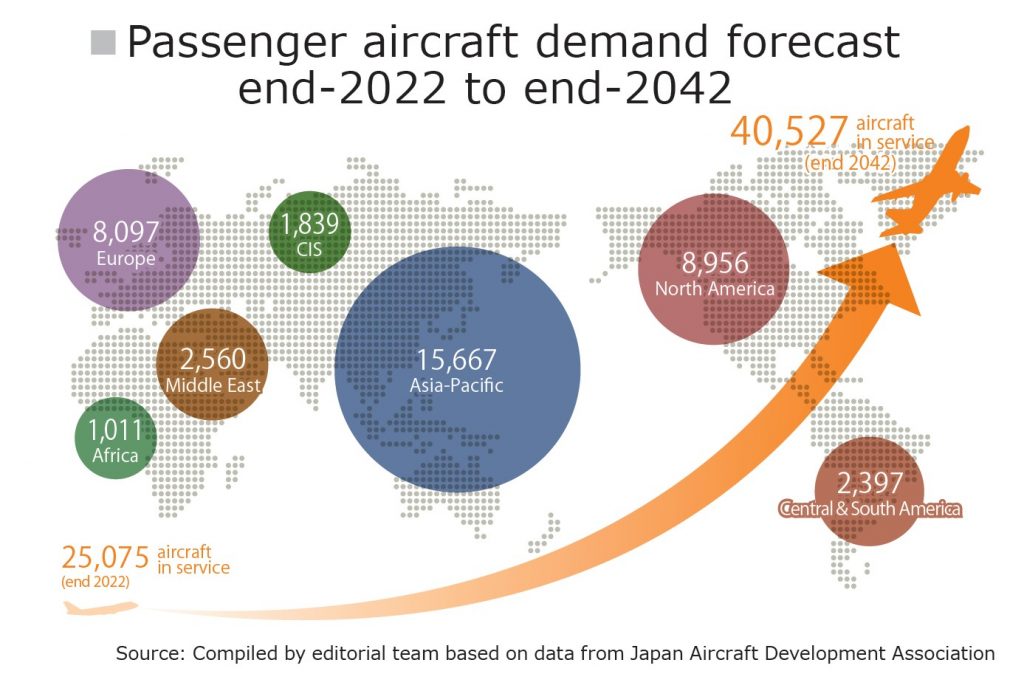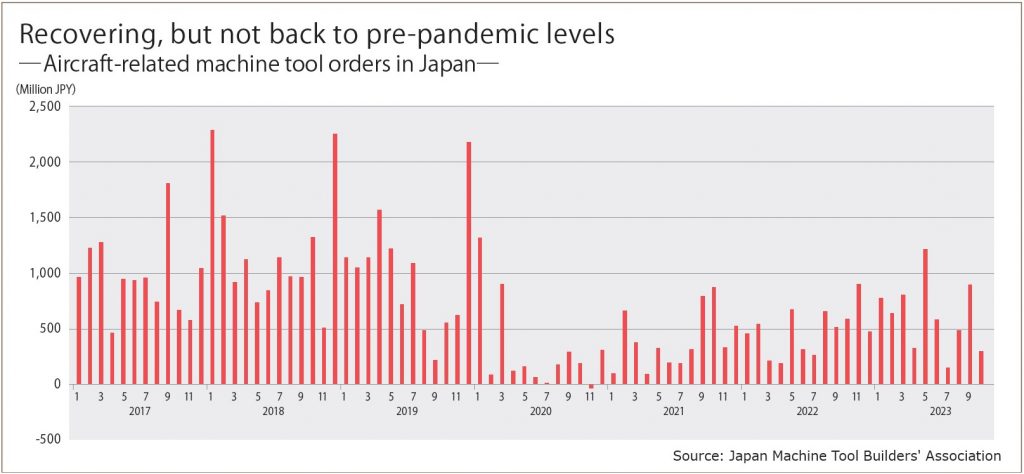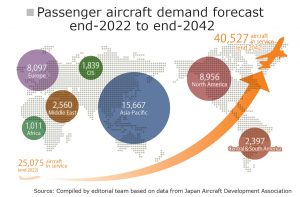
- News
- Basics
- Products
- JP Job shop
- Exhibition
- Interview
- Statistic
- PR
- Download
- Special contents
News
January 30, 2024

The aerospace industry is a market where both aircraft and space equipment are expected to grow in the medium to long term. The aircraft industry has recovered from the damage caused by COVID-19 and is expected to exceed pre-pandemic levels this year. The number of aircraft in service is expected to increase to 1.6 times the number at the end of 2022 by the end of 2042. The space industry is also expected to grow to about three times its current size by 2040, with a corresponding increase in demand for machining of rocket and satellite parts.
The aircraft industry is gradually recovering from the devastation of the pandemic.
The International Air Transport Association reported last December that revenue passenger kilometers (RPK), an indicator of demand for air travel, are expected to grow 9.8% this year compared to last year and 4.5% from 2019, eventually surpassing pre-pandemic levels. Last year’s RPK (estimated) was 38.4% higher than the previous year and 4.8% lower than 2019, a step below pre-pandemic levels, but the aircraft industry has taken three years to recover from 2020, which was the “worst year in history” for the industry brought on by the pandemic.
Demand for capital investment is also beginning to recover. According to the Japan Machine Tool Builders’ Association (JMTBA), orders for aircraft increased 39.8% YoY to 6,176 million yen from January to October 2023. While all major industries of domestic demand for machine tools, such as automobiles and general machinery, were sluggish across the board, orders for aircraft increased YoY, and Dr. Eng. Masahiko Mori, President of DMG MORI, pointed out, “The machining of parts for maintenance and repair, known as MRO, has become more active”.
Currently, airlines are reviewing their aircraft fleet plans in response to the recovery in RPKs, and as a result, production of passenger aircraft is expected to increase in the future. Although orders for machine tools for aircraft have not yet returned to pre-pandemic levels, this trend toward increased production is expected to further boost order momentum. 
The aircraft industry is expected to grow at a high rate in the medium to long term. According to the Japan Aircraft Development Association, the average annual growth rate of RPK is expected to be 3.4% through 2042. Accordingly, the number of passenger aircraft in service will increase 1.6 times from 25,075 at the end of 2022 to 45,527 at the end of 2042. The breakdown will be 15,452 for new demand, 17,903 for replacement and 7,172 for existing aircraft.
 This growth is expected to be driven by “narrow-body” aircraft, which have a single-aisle cabin. 30,177 aircraft, or 74.5% of the total, will be in service at the end of 2042, a 1.8-fold increase from the 17,147 aircraft in service at the end of 2022.
This growth is expected to be driven by “narrow-body” aircraft, which have a single-aisle cabin. 30,177 aircraft, or 74.5% of the total, will be in service at the end of 2042, a 1.8-fold increase from the 17,147 aircraft in service at the end of 2022.
By region, the Asia-Pacific region, which includes China, will have the largest share, with 15,667 aircraft at the end of 2042, or 38.7% of the total.
Boeing of the United States and Airbus of Europe also make such medium- to long-term forecasts every year, and both companies generally have similar views.
In addition to aircraft, the space business is also expected to grow in the medium to long term. According to a forecast by Morgan Stanley of the United States, the space business is expected to grow to US$1 trillion (about 145 trillion yen) by 2040, about three times the current level.
The space business is broadly divided into the “space equipment industry,” which includes rockets and satellites, and the “space utilization industry,” which uses space as infrastructure. Currently, the main markets are Europe and North America, but Japan has also begun to strengthen its space business, and on June 13, 2023, Japan revised its “Basic Plan on Space Policy,” which outlines its basic policy for space development, with the goal of increasing the market size from 4 trillion yen in 2020 to 8 trillion yen by the early 2030s.
Since rockets and satellites contain numerous metal parts, demand for parts machining is expected to increase with the expansion of the space equipment market.
In the manufacturing industry, the aircraft and space equipment industries are often referred to collectively as the “aerospace industry“. Both aircraft and space equipment are markets that are expected to grow strongly in the medium to long term. Yamazaki Mazak analyzes the trend: “The aircraft industry is showing signs of recovery as demand for travel recovers. And, especially in North America, there is increasing investment from the private sector in space exploration”.
The aerospace industry is dominated by high-mix, low-volume production, and many workpieces have complex shapes. For this reason, additive manufacturing (AM) has been gaining attention in recent years as a cutting-edge technology for reducing manufacturing lead times and consolidating processes. An insider from a metal 3D printer manufacturer in a non-Japanese company said, “The aerospace industry is where AM technology is most widely used. A number of companies in Europe and the United States are already using AM technology to produce engine parts”.
The aerospace industry is also facing an inevitable labor shortage, and automation of the manufacturing process is positioned as an urgent issue. However, because the industry is not mass-produced, automation is not easy. Aircraft manufacturers are trying to design and build highly automated systems, and business opportunities can be expected in these engineering areas.
By: Atsushi Kuwasaki
Staff Editor, SEISANZAI Japan
January 24, 2024
January 11, 2024
January 5, 2024